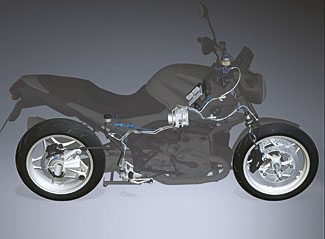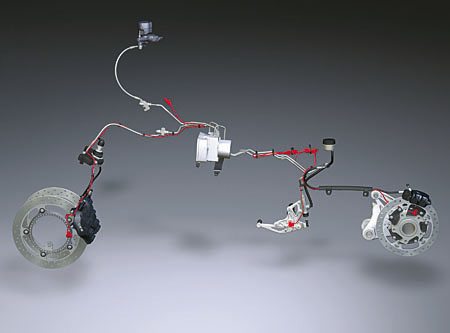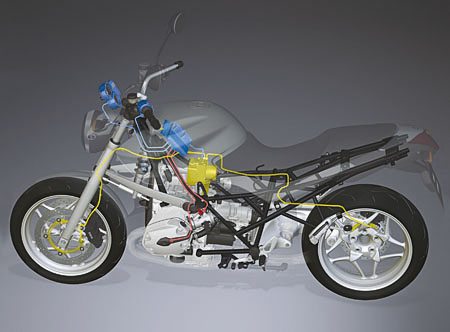BMW Announces Motorcycle Automatic Stability Control System
BMW has announced the availability of their first motorcycle “stability control” (looks like traction control to us) system for street bikes.
The system uses the BMW Motorrad Integral ABS system and advances it from a stand-alone solution acting only on the brakes into a fully networked all-around system.
With this new generation of Integral ABS, BMW has developed a foundation for additional dynamic riding control systems with a reduction in technical requirements and features. The new technology also opens up the option in future for further-reaching rider assistance functions.
The first step in this direction is BMW Motorrad ASC Automatic Stability Control available as of 2007. This first system in the world serving to control drive spin on a production motorcycles is being introduced as an optional extra on the touring models in the BMW K and Boxer Series, rather than the R1200R as has been reported.
BMW claims that they are “acting as the pioneer in the introduction of advanced safety technologies on the motorcycle. This further enhances the leadership which BMW Motorrad has shown in the area of active safety for more than 15 years”.
NOTE From Visitor “B.M.: “The article states it is the “first system in the world serving to control drive spin on a production motorcycles”. At any rate, it’s wrong. Honda introduced the same thing on their ST1100 ABS-TCS in 1992, 15 years earlier. And it works great. It uses the ABS sensors as does BMW, and it also modulates engine power also, as does BMW. Seems BMW is 15 years late to the party.”
BMW wanted to choosing the right development partner for both systems, so they had to focus on that partner’s specific competence in control technology and the networking of functions within the vehicle.
In recent years, major car suppliers have become aware of the technical challenges presented by the motorcycle with its specific riding dynamics and the growing potential for motorcycle control systems in the market.
The decisive point in pre-selection of the development partner was the willingness and ability to develop specialized solutions suitable for use on BMW motorcycles. So taking this into account, joint development of the new generation of ABS brake technology started together with Continental-Teves in early 2003.
Integral ABS
BMW’s new Integral ABS technology has been developed separately from the previous system and the entire layout of the system has been newly conceived from the ground up. Capitalizing on progress in technology in both hydraulics and electronics, the development engineers have succeeded in simplifying the architecture of the system while at the same time enhancing its functions. The result is stopping power and very short stopping distances even without electrical power assistance on the brakes.
The new Integral ABS is no longer based on the plunger principle or, respectively, the ram pressure process used on previous generations, but instead is conceived as a valve system. Carried over from automotive applications, this control concept is now able to ensure a very high standard of all-round comfort and convenience.
In particular, feedback of brake pressure modulation on the brake lever has been reduced by recent development of the control valves and management to such an extent that it no longer has any kind of adverse effect, thus paving the way for introduction of the new system in other BMW motorcycles.
The new Integral ABS system applies brake pressure on the front wheel brake solely by means of a hydraulic circuit, thus acting entirely in response to the operating forces applied on the hand lever. This is claimed to provide a more direct feeling of the brakes particularly important to the sports-minded rider. Also, the rider should no longer have to get used to any change in control or operation of the brakes when switching over from a motorcycle without ABS.
The new system naturally maintains the proven semi-integral function, that is automatic activation of the rear-wheel brake when operating the front-wheel brake. Pressing the rear brake alone, however, the rider, as in the case of a conventional system, activates only the wheel brake at the rear.
As with the previous system, the advantages of this integral brake are ideal brake force distribution on both wheels under all conditions, naturally taking load conditions into account, as well as enhanced control enabling the rider to detect at an early point the risk of the rear wheel lifting off when applying the brakes all-out, and to take appropriate counter-action.
To provide the desired integral function, brake pressure for the rear-wheel circuit is generated and built up by an electronically controlled hydraulic pump. This offers the advantage of pressure management and control completely independent of the front wheel circuit – which is the prerequisite for dynamic, adaptive and, ultimately, consistently ideal brake force distribution to the rear wheel as well as fully independent brake management and control.
In the event of any deficiencies in the hydraulic pump or electrical components, the rear-wheel brake acts hydraulically as with a conventional system, overriding the integral function. This has no effect on the proper operation of the front-wheel brake, the only difference being that the ABS function is no longer operative in the event of such a deficiency.


Automatic Stability Control
Automatic Stability Control is a meaningful, additional assistance function particularly on a high-torque motorcycle and when riding under varying conditions with slippery surfaces. Indeed, ASC is the logical counterpart to ABS.
Automatic Stability Control prevents the rear wheel from spinning uncontrolled when accelerating all-out and thus avoids any loss of side forces and stability which otherwise would make the rear wheel swerve out of control. Lift-off detection and intervention serves furthermore to prevent the front wheel from moving up when accelerating under full power.
Acting together, these two functions enhance riding stability and thus help to ensure a higher standard of safety on the road. BMW’s system will allow the rider to deactivate ASC at any time, also while riding.


Like ABS, ASC is naturally also subject to certain restrictions in bends due to the riding physics of a motorcycle. And it is essential to note that ASC is not able to push forward, let alone override, the physical limits to the stability of a motorcycle when leaning over in a bend.
In its basic principles, the system and its various functions are quite straight forward: The ABS wheel sensors determine the speed at which the wheels are turning. Registering any sudden change in the difference in speed front-to-rear, the electronic control unit is able to detect any risk of the rear wheel spinning, engine management responding immediately by intervening in the ignition angle to take back engine power. Should this not be sufficient, that is should a greater reduction of engine power be required, fuel injection will be cancelled out for a certain time.
This kind of control and management is fast and sensitive, with any effects on riding comfort and dynamics being virtually negligible, claims BMW.
Note: For informational use only. All material and photographs are Copyright © webWorld International, LLC – 2000-2013. All rights reserved. See the webBikeWorld® Site Info page. NOTE: Product specifications, features and details may change or differ from our descriptions. Always check before purchasing. Read the Terms and Conditions!




